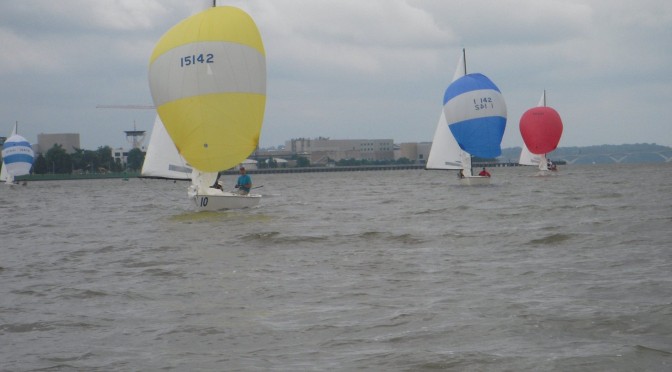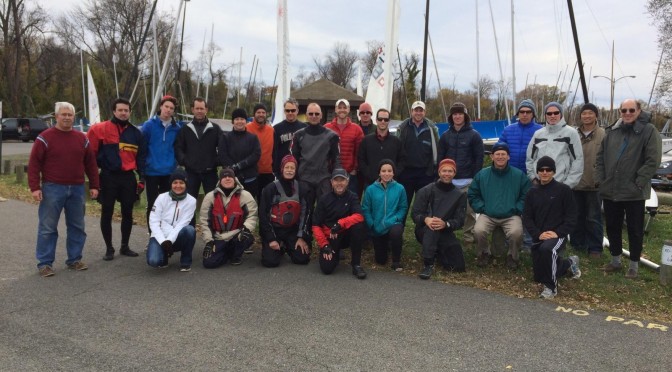The forecast was fairly accurate with some rain before racing and overcast the rest of the day and moderate winds at 9 and below. It made for a good day to race on the river. Jim Graham, pro for the day, said not to dawdle on shore as he was going to start races at 12:30 when 6 boats were on the line. Good decision. I dawdled and heard the 3 minute gun when I was 3.5minutes from the committee boat. Being late, I started at the pin and headed right as everyone else had gone way left. The wind seemed to be a little stronger on the right most of the day and in the first race I played right and caught a few boats. I just sailed on the lifts and puffs as they came in most cases was further right than the majority of the fleet. Downwind was slow and I kept left while some competitors went right and caught more wind. I tried to minimize my usual mistakes, didn’t foul anyone, made clean if not fast rounding’s and didn’t get into squabbles with other lasers.
During the races I sailed on my own and didn’t pay particular attention to the rest of the fleet. This helped me keep focus but was a mistake in the 3rd race when 2 boats caught me 40 yards from the finish. In that race I fell behind but got a burst of air on the right and hiked out of the first time and reached into the mark as I had overstood.
Lessons learned: be on time, minimize mistakes, good starts, clear air. As we get more lasers racing the hardest part seems to be getting the lasers docked and up the ramp. Thanks everyone for helping each other !! And good race committee work as well !!
For more details here is Cary Comer’s observations. Welcome back Cary !
According to the powers that be, I may have come in third place…or, I may have come in close enough such that a few shaved points may have bestowed this responsibility upon me. Regardless of how it came to be, here’s my take on today. Given this was my first time out in about a year, I was mostly focused on two basic things: stay dry; and, come home in one piece (those that know me are aware that these are both challenging).
Today was generally a damp, light day. Winds were consistently between 5 and 8mph from the north. We sailed out in the river, almost due east of the ramps. There was no traffic on the river aside from the steady flow of aircraft landing at DCA. The current was moving pretty fast as high tide was at 10:30. Jim and Nic got off four races before calling the day as some weather threatened from the north.
Starts were relatively straight-forward today, as there was plenty of space on the line, the ends were relatively square and there was not much fighting over positioning. I really wanted to have clear air and stay out of the current heading upwind, so tended to mind my own business and focused on starting down by the pin. It was important to keep a hole to leeward to allow for acceleration in the last five seconds before the gun, which I was moderately successful in keeping for two of the four starts. Over the course of the day with the breeze tending to fill more so on the right, the pin didn’t really pay off much, so by the last race, I started right at the boat.
Going upwind, clear air seemed critical–when I didn’t have a clean angle, I would tack out and come back when I had a better lane. For a couple of the beats, the breeze would shift way off to the right allowing us to sail way above the mark at times, but you had to stay aware to make sure your trim was right as the breeze bounced around. Another interesting thing about the beats was the windward mark rounding–given the current and the light breeze, it was easy to get caught pinching up to the mark and losing speed particularly as things got congested. I saw a few people coming in from the left have to tack out at the last minute to avoid this bottleneck. Lastly, with the breeze shifting, I got greedy trying to cross someone on starboard as I was getting headed, and ended up fouling him. That was a blessing in disguise: I did my turns, went back out to the left for some clear air, and made out much better than I had been prior to the foul.
Downwind was a different story, as this was not a strength for me today. I’d like to blame the Thanksgiving over-eating for my dragging performance there, but it’s probably more a combination of bad decision-making, poor boat-handling, and being heavier than I once was. I tried a number of different approaches like heading to the boat-side of the leg to ride the current (which didn’t pay off) as well as sailing by the lee whenever I could (also didn’t pay off). All the while, I wasn’t really looking upwind enough to see the puffs and how others were setting up, and this cost me a lot of time in all races.
Leeward mark roundings were a great opportunity to make up distance today, as the short races allowed for a lot of congestion here. The current was pulling people way south of the mark as they made their way through their turns, so starting my turn wide and early helped me stay tight to the mark and gave me speed coming out of the rounding. More times than not, I was able to sneak inside of a boat or two, as well as have a better angle coming into the beat and some clear air to work with.
Thanks to all for a fun afternoon–I hope to see everyone out there again soon. Maybe even next Sunday–I may surprise you.
2015-2016 PRSA Laser Frostbite Series 2


